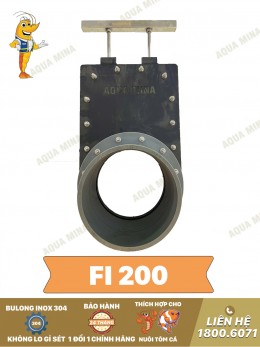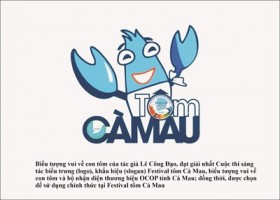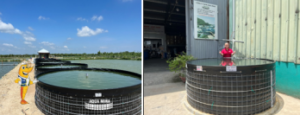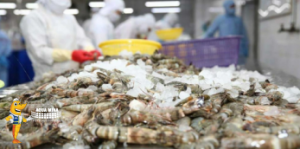Aquaculture Development in Indonesia and Lessons for Vietnam
INTRODUCTION
Indonesia is an archipelagic country with over 17,508 islands and a coastline of about 81,000 km and has great potential for aquaculture. The aquaculture sector plays an important role in the development of the Indonesian national economy. On average, the aquaculture sector contributes 5.2% to the country's GDP each year. Total aquaculture production reaches 3.1 million tons. Aquaculture contributes 34.5% of the country's total aquaculture production. Aquaculture production increases by about 33.1% per year from 2,304,800 tons (in 2020) to 3,095,585 tons (in 2022) (FAO, 2022). Therefore, studying the aquaculture experience in Indonesia will be a valuable lesson for Vietnam in developing this field.

INDONESIA'S EXPERIENCE IN AQUACULTURE DEVELOPMENT
Aquaculture has been playing a role as an alternative source of income for coastal fishing communities, as well as contributing to reducing pressure on marine natural resources. In recent years, Indonesia's aquaculture industry has developed rapidly and is now considered an important economic sector in supporting rural economic development. Indonesia has 26 million hectares of coastal areas, in addition to biodiversity values that play an important role in the ability to respond to climate change, the ecosystem is the foundation of economic sectors such as fisheries and tourism.
About aquaculture area
Indonesia's potential aquaculture area is about 15,590,000 hectares, including 2,230,000 hectares of freshwater aquaculture, 1,220,000 hectares of brackish water aquaculture and 12,140,000 hectares of sea surface. Indonesia's aquaculture sector has only utilized about 50% of its total potential aquaculture area. Specifically, 10.1% of the freshwater area, 40% of the brackish water area and 0.01% of the marine area have aquaculture potential (Badan Pusat Statistik, 2022). The most popular aquaculture species in Indonesia include carp, catfish (catfish, pangasius, basa) and Nile tilapia. In 2018, brackish water aquaculture ponds increased dramatically with the successful development of the eyestalk ablation technique to stimulate shrimp spawning. The number of hatcheries has also grown dramatically. Many private economic households in Sumatra and Lampung provinces have converted brackish water ponds into industrial ponds following the nuclear farm model. The government also issued a circular banning trawl fishing to promote the development of brackish water aquaculture.
In the initial stage of brackish water aquaculture development, milkfish was selected as the main aquaculture species. Later, milkfish were co-cultured with tiger prawns and whiteleg shrimp to increase economic value. Farmers diversified aquatic species, switching to giant freshwater prawns, pangasius, basa fish, and carp. The number of floating rafts for raising Catarum river carp increased rapidly. In addition, Nile tilapia was also considered a potential farming species and was facilitated to expand production. After the white spot disease devastated the tiger prawn industry, the Indonesian government also encouraged farmers to focus on farming and giant freshwater prawns with high disease resistance. These two species were raised quite successfully in East Java, Lampung and Bali. Indonesia also experimented with raising exotic aquatic species, such as: Chinese grass carp, Taiwanese hybrid tilapia, Philippine red tilapia and GIFT tilapia, and Asian and South American freshwater ornamental fish. Pearl, oyster and abalone farming is also developing strongly in Indonesia, promising to bring many sources of foreign exchange revenue to the country. In terms of aquaculture production
Indonesia’s aquaculture industry has grown strongly over the past decade, reaching 6.2 million tons in 2022 alone, ranking behind only China and India in terms of output. While marine capture fisheries production increased by about 34% from 2018 to 2022, Indonesia’s aquaculture industry exploded by 264% during that period (FAO, 2022).
Indonesia’s total aquaculture production in the 2018-2022 period increased by an average of 49.68%, from 3.19 million tons to 4.78 million tons. The largest contributor to Indonesia’s aquaculture growth was the increase in pangasius production, which increased by 260%, from 36,755 tons in 2019 to 185,670 tons in 2022. This was followed by catfish, which increased by 118%. Perch
82% and seaweed 49%. Of which, global aquaculture production increased by 527% during the period 1990-2020, with Indonesia among the leading aquaculture countries worldwide.
According to FAO (2022), the country's aquaculture production in 2021 was 12.25 million tons, up 6% over the same period in 2020. Indonesia's aquaculture industry contributed the equivalent of 1.94 million USD in non-tax state revenue for the year ending November 2021, much higher than the target figure of 1.39 million USD.
In 2022, Indonesia's aquaculture production was 21.25 million tons, up 7.3% over the same period in 2021. In 2022, Indonesia's aquaculture industry contributed the equivalent of 2.18 million USD in non-tax state revenue. These successes have made Indonesia the leading seafood exporter in Asia, after China and India (Badan Pusat Statistik, 2022).
The aquaculture industry employs about 3.3 million direct workers, expected to supply nearly two-thirds of global fish consumption by 2030. In particular, the effective application of technology such as data analysis and the Internet of Things (IoT) system helps the industry continue to grow sustainably.

The growth rate of Indonesia's aquaculture industry has always been at an increase of about 9.34%/year. Aquaculture area and output have increased rapidly, with seafood export value continuously increasing from 1,584.5 million USD (in 2010) to 3,181.9 million USD in 2020 (Ministry of Fisheries Indonesia, 2021), accounting for 3% of Indonesia's GDP; Infrastructure - technology (electricity, irrigation, transportation) and service systems (seed production systems, laboratory systems, feed factories, biological products) have been improved to meet the demand for aquaculture; Most of Indonesia's concentrated aquaculture areas are supported by the Government to be raised according to Indonesian Gap (Indonesian Good Aquaculture Practices) standards and some farming areas meet international standards ASC, Naturland and GlobalGAP.
Regarding seafood export value
In 2020, the total seafood export turnover reached 5.2 billion USD, of which
4.84 billion USD came from fish consumption. Indonesia has about 2,191 fish processing units
for export to 157 countries. Of which, Indonesia's shrimp exports have grown
continuously by 24%-29% in the past 5 years (2015-2020). Indonesia's largest shrimp import market
is the United States. In 2019, Indonesia's shrimp exports to the US increased sharply by 44%, the highest growth rate among the top 5 suppliers to the US (Ministry of Fisheries Indonesia, 2021).
The Indonesian Ministry of Fisheries (KKP) said that seafood exports reached US$2.1 billion in 2021, up 4.94% year-on-year. High-value export items included shrimp at US$865.9 million, accounting for 41% of total export value; tuna and mackerel at US$269.5 million, accounting for 12.7%, and octopus at US$223.6 million, accounting for 10.6%. The United States remained Indonesia's main export market, with a turnover of US$934.1 million, accounting for 44.2% of total exports, followed by China with US$311.2 million, equivalent to 14.7%, and other ASEAN countries with US$230.7 million, accounting for 10.9% (Ministry of Fisheries Indonesia, 2021).

Indonesia is the world's leading exporter of frozen seawater shrimp. Some of Indonesia's top export species include Asian tiger shrimp (Penaeus monodon) and whiteleg shrimp (Litopenaeus vannamei). According to data from the Indonesian Chamber of Fisheries and Aquaculture Production, Indonesia exported 239,000 tons of shrimp in 2020, up 15% from 2019, with whiteleg shrimp accounting for 75%, black tiger shrimp 16%, and sea shrimp 9%. In 2022, the country's shrimp exports will reach 250,000 tons, with an export value of 1.73 billion USD, up 8% compared to 2021, ranking 8th in the top 10 largest seafood exporters in the world in 2022 (Badan Pusat Statistik, 2022).
SOME SUGGESTIONS FOR VIETNAM
* Current status of aquaculture in Vietnam
Vietnam has great potential for aquaculture development. The coastline is more than 3,260 km long with 112 estuaries and creeks with rich potential for brackish and saltwater aquaculture. The system of rivers and canals in our country is very diverse and dense, with up to 15 rivers with a basin area of 300 km2 or more (General Statistics Office, 2022). In addition, there are thousands of large and small islands scattered along the coastline that are areas where aquaculture can be developed year-round. In the sea area, there are 4,000 large and small islands, including large inhabited islands such as Van Don, Cat Ba, Phu Quy, Con Dao, Phu Quoc, with many bays, lagoons, inlets, and ocean currents, which are both favorable fishing grounds and places with many natural conditions for developing marine aquaculture and building fishing logistics bases. In addition to the natural conditions of the sea, Vietnam also has freshwater aquatic resources in 2,860 large and small rivers, millions of hectares of wetlands, ponds, low-lying fields, and mangrove forests, especially in the Red River and Mekong River basins.
Aquaculture is gradually becoming one of the key commodity production industries, developing widely, holding an important position, and moving towards building concentrated production areas. According to VASEP data, in the period 2015-2022, Vietnam's aquaculture output increased from 3.53 million tons to 5.19 million tons, up 47%. Aquaculture for export is mainly concentrated in the Mekong Delta (accounting for 95% of total pangasius output and 80% of shrimp output). The country has 2,362 brackish water shrimp seed production facilities (1,750 black tiger shrimp seed facilities and 612 whiteleg shrimp seed facilities). Production is 79.3 million shrimp seeds (15.8 million tiger prawns; 64.1 million white-leg shrimp. Marine farming area is 260 thousand hectares and 7.5 million m3 of cages; output reaches 600 thousand tons. Of which, marine farming is 8.7 thousand hectares and 3.8 million m3 of cages, output is 38 thousand tons; mollusks are 54.5 thousand hectares, 375 thousand tons; lobsters are 3.7 million m3 of cages, 2.1 thousand tons; seaweed is 10,150 hectares, 120 thousand tons; the rest are sea crabs and other farmed species: cold-water fish (salmon, sturgeon... reaching 3,720 tons, 2 times higher than in 2015 (1,585 tons). In 2022, aquaculture continues to develop due to increased output of key products such as pangasius and white-leg shrimp. Aquaculture output in 2022 2022 reached 3,611.2 thousand tons, up 7.2% over the same period in 2021. However, aquaculture areas are still small and scattered, making it difficult to develop disease-free farming areas; the transfer of aquaculture techniques and the application of science and technology in aquaculture are still ineffective, and fisheries extension is not really suitable for the ability to receive information of aquaculture workers, so the effectiveness has not reached the expected level.
* Some recommendations
From the experience of Indonesia and the current situation in Vietnam, according to the author, in order for Vietnam's aquaculture to accelerate and reach out to the world, it is necessary to implement the following solutions:
First, research and apply the method of spatial planning for the development of the aquaculture industry, focusing on planning according to commodity development, focusing and paying attention to the production and ancillary service industries (seed production, feed, biological products) and seafood processing and export technology. Increase aquaculture output for export, especially focusing on enhancing competitive advantages through the development and application of efficient and environmentally friendly technologies. The government supports the construction and consolidation of technical infrastructure (electricity, irrigation, transportation) and improved service systems (seed production systems, laboratory systems, feed and biological production plants) to better meet aquaculture needs; invest in restoring and improving aquaculture service systems: electricity, irrigation, seed production systems, laboratories, etc.
Second, the State needs to have policies to encourage and attract scientific and technical resources, investment capital, especially capital from enterprises and international investors, to increase the competitiveness of the aquaculture industry. Develop aquatic products for domestic consumption, especially focusing on strengthening and consolidating infrastructure in farming areas. Spend on developing and improving sustainable farming areas (on land and at sea) to increase aquaculture output for export; establish a mechanism to control the production, purchase and sale of feed, chemicals, biological products and equipment for aquaculture, etc., especially focusing on enhancing competitive advantages through investment and application of efficient and environmentally friendly technology.
Third, Vietnam can learn from the experience of Indonesian experts on shrimp farming techniques for Pacific White Shrimp farming areas in semi-intensive shrimp farming models, which is to limit high stocking density. The best stocking density for the models: traditional (extensive): 7,500-12,000 seeds/ha/crop; semi-intensive: 30,000-60,000 seeds/ha/crop; Intensive: 100,000-150,000 seeds/ha/crop and integrated farming: 1,500-9,000 seeds/ha/crop.
To support the development of the aquaculture industry, especially in the Enhanced Aquaculture Program, Vietnam can learn from the Indonesian Government in developing a reputable and quality source of seeds. From there, proceed to establish the National Aquaculture Seed Center (NBC) and the Local Aquaculture Seed Center (RBC). NBC and RBC focus on in-depth research on identified potential farming objects such as shrimp, grouper, tilapia and seaweed. In addition to collecting seeds from the locality, RBC and NBC work closely with research institutes and universities to find the best production methods. These two centers have produced parent shrimp (whiteleg shrimp, South American green shrimp, and penaeid shrimp), super male tilapia, and SPF disease-free shrimp seeds.
Fourth, complete and restructure cooperatives in the direction of social enterprises like Indonesia to be able to take advantage of investment from enterprises, be proactive in business and calculate revenue and expenditure. Establish a mechanism to control production, purchase and sale: food, chemicals, biological products and equipment for aquaculture... Gradually develop and improve farming areas in a sustainable direction (on land and at sea). Fifth, improve VietGap standards in a simple direction and gradually update them so that shrimp farmers can easily implement them. Develop aquaculture in the direction of goods (applying warehouses a technical training, market expansion, foreign investment attraction and human resource enhancement...); restore and improve the system serving aquaculture: electricity, irrigation, seed production system, laboratories.../.
Master. Nguyen Van Long - Academy of Logistics
(According to the Journal of Economics and Forecast, No. 02, January 2024)
Contact AQUA MINA for consultation and supply of aquaculture round tanks and aquaculture equipment for high-tech shrimp farming.
- Address: 685 National Highway 1A, Binh Hung Hoa Ward, Binh Tan District, Ho Chi Minh City
- Phone: 1800 6071 (Toll-free hotline)
- Email: sales@aquamina.com.vn or oversea@aquamina.com.vn
Aqua Mina's distributor in Japan:
REX INDUSTRIES CO., LTD
- Address: 1-9-3 Hishiya-Higashi, Higashi-Osaka 578-0948 JAPAN
- Email: kimakubo@rexind.co.jp
- Phone: +81-(0)72-961-9893
- Website: http://www.rexind.co.jp/e/

WE WORK FOR YOUR SUCCESS!
Ngày đăng : 02/12/2024
2931 View
Other Articles
Vietnamese shrimp and catfish choose a sustainable path in global competition
End-of-Season Shrimp Prices Reach Record Highs
Norway – Russia Reach Barents Sea Fisheries Agreement for 2026
Cà Mau strengthens traceability to enhance the competitiveness of the shrimp industry.
Cold stress: Effects on the plasma characteristics of whiteleg shrimp.
A new breakthrough in the prevention of diseases caused by the microsporidian parasite EHP in shrimp farming
Vietnam’s shrimp export outlook in the first quarter of 2026 continues to face heavy pressure from tariffs.
New England’s shrimp fishery to shut down for the long haul after years of decline
Crab exports to the United States account for more than 80%.
Thailand sets a target to increase shrimp production to 400,000 tons by 2026.
CTU-RAS: Recirculating Shrimp Farming for Sustainable Development
Vietnamese aquatic products reach new markets



















.jpg)